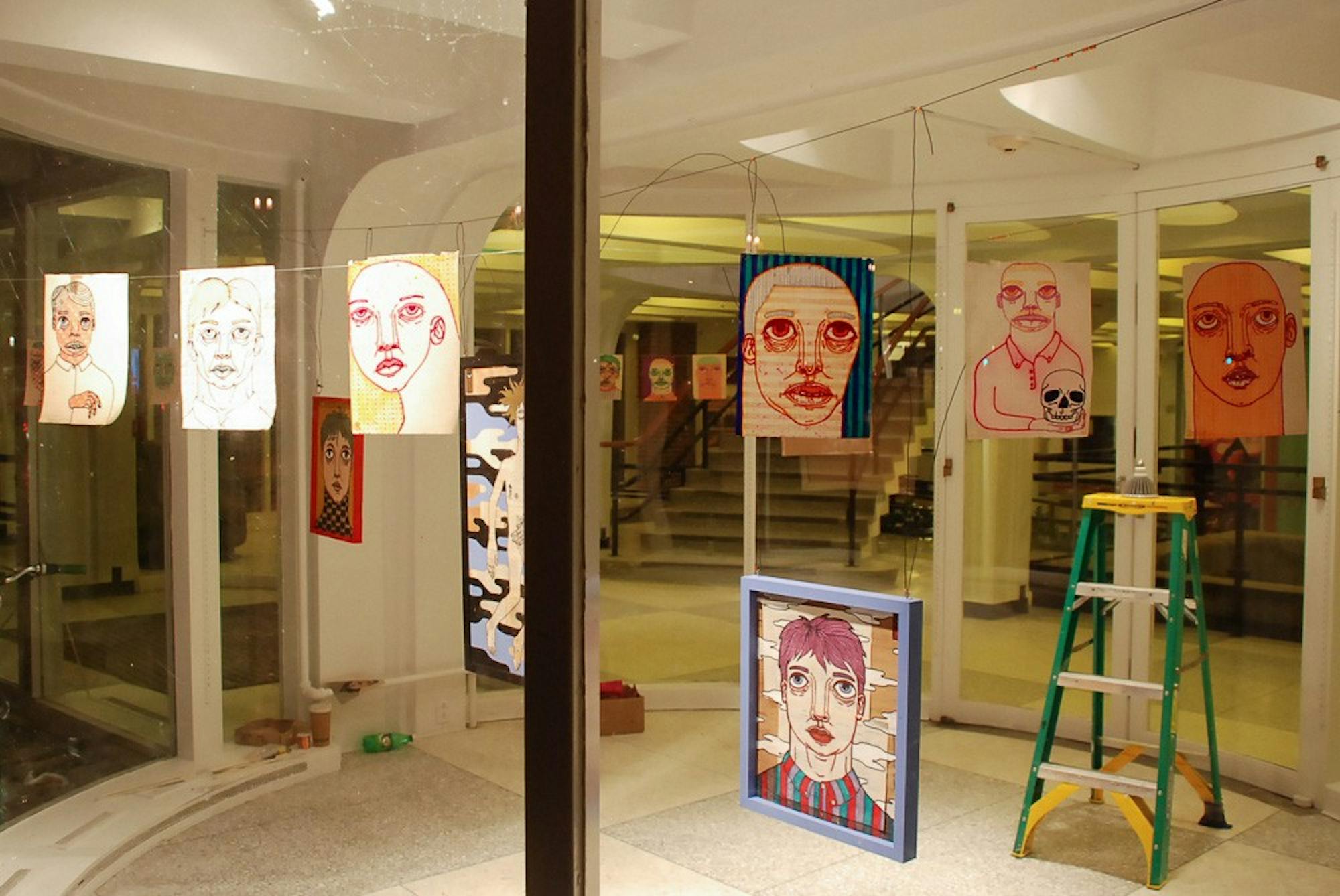The Barrows Rotunda, the circular space that greets passersby as they enter and exit the Hopkins Center, will showcase the work of studio art intern Julian MacMillan ’14 until Nov. 25. A product of months of work, “The Not Knowing” is MacMillan’s first exhibit, an “exciting and nerve-wracking” experience, he said.
MacMillan arranged small notebook drawings along the glass walls of the rotunda, with his five larger paintings suspended at different levels in the center. The vintage notebook graph paper MacMillan used for the drawings becomes almost translucent in the sunlight, creating a stained glass effect. Illuminated, the colors pop in the sunlight.
The series presents an eclectic amalgam of patterns, faces and colors. MacMillan’s use of color arises from an “organic” process, he said. Defying color conventions, his portraits attract the viewer with their unconventionality, but the faces hold their own stories that transcend the image.
His use of notebook paper harkens back to when he first started drawing by doodling in class, he said.
“This practice of drawing patterns is meditative and almost childlike,” MacMillan said. “Here, I’m approaching it through adult themes.”
MacMillan’s larger paintings are comprised of various “found objects,” he said. Some paintings use old math tests printed on yellowed paper as their background, while others cover old textbook paper with interesting graphics.
“I like found objects that have their own history,” MacMillan said. “I like that tension of putting my own images, things I’ve created, with things that existed before me.”
MacMillan, a studio art major at the College, said his exhibit grew from a collection of drawings he started working on while exploring Peru with his family over the summer.
“I’ve continued making them and they’ve gotten bigger and bigger,” MacMillan said. “I started in this tiny, little notebook doing a lot of patterns — abstract stuff. Then I started building those up, and those became studies for the paintings that will be in the show as well.”
Peruvian textiles’ patterns indirectly influenced his work. They were on his mind while he drew, he said.
While MacMillan usually creates larger paintings, he said that the small drawings that form the show’s centerpiece work well together in a group, as they use the same “visual language” and “figure.”
“It’s almost a repetition of the same face over and over, but it’s different every time, he said of the small drawings. “I think all of those iterations read really nicely.”
MacMillan said his father, a portrait photographer, influenced his compositional process.
“Most of my work is figurative,” he said. “I think a lot about gesture and hands as a way to convey emotion.”
The personal nature of MacMillan’s work lends it “its own voice,” studio art professor and exhibition program director Jerry Auten said.
Studio art lecturer Jennifer Caine has worked with MacMillan since 2010, when he was a student in her printmaking class. Caine said that through his use of subtle “features of character” and “allusions to narrative,” MacMillan conveys a range of human experiences.
“I think the strength of his pieces lies in his ability to combine a strong sense of craftsmanship with a strong sense of color,” Caine said. “He has a certain inventiveness with his approach to materials and abstraction of figuration.”
MacMillan said his work focuses on “the tensions between opposing things and not necessarily knowing which is the better or right way.”
In his entry in the spring 2014 studio art major exhibition catalogue, MacMillan wrote that he strives “for the point between delicate execution and intuitive flow, elegance and vulgarity.”
The rotunda’s shape can be restrictive, Auten said. MacMillan said he wants to take advantage of the circular nature of the space and that people frequently pass it.
The studio art faculty selects five graduating studio art majors or minors to participate in the intern program.
The department seeks mature, dependable and collaborative artists.
“It’s not an honor — it’s a job. They work in the department and help teach,” Auten said.
MacMillan was assigned to be a teaching assistant for sculpture and architecture classes this term. Although MacMillan did not have extensive experience with these disciplines, he said the classes have exposed him to new tools, materials and ideas.
While MacMillan came to Dartmouth not intending to pursue studio art, he changed his mind after taking Drawing 1 during his freshman fall. He said he applied for the studio art intern program because he wanted another year to focus on making work without having to worry about paying for studio space. Although he is not certain about what he wants to do in the future, MacMillan said he is considering attending graduate school.




